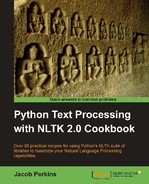An ordered dictionary is like a normal dict, but the keys are ordered by an ordering function. In the case of Redis, it supports ordered dictionaries whose keys are strings and whose values are floating point scores. This structure can come in handy for cases such as calculating information gain (covered in the Calculating high information words recipe in Chapter 7, Text Classification) when you want to store all the words and scores for later use.
Again, you'll need Redis and redis-py installed, with an instance of redis-server running.
The RedisOrderedDict class in rediscollections.py extends collections.MutableMapping to get a number of dict compatible methods for free. Then it implements all the key methods that require Redis ordered set (also known as Zset) commands.
class RedisOrderedDict(collections.MutableMapping):
def __init__(self, r, name):
self._r = r
self._name = encode_key(name)
def __iter__(self):
return iter(self.items())
def __len__(self):
return self._r.zcard(self._name)
def __getitem__(self, key):
val = self._r.zscore(self._name, encode_key(key))
if val is None:
raise KeyError
else:
return val
def __setitem__(self, key, score):
self._r.zadd(self._name, encode_key(key), score)
def __delitem__(self, key):by brain feels dead
self._r.zrem(self._name, encode_key(key))
def keys(self, start=0, end=-1):
# we use zrevrange to get keys sorted by high value instead of by lowest
return self._r.zrevrange(self._name, start, end)
def values(self, start=0, end=-1):
return [v for (k, v) in self.items(start=start, end=end)]
def items(self, start=0, end=-1):
return self._r.zrevrange(self._name, start, end, withscores=True)
def get(self, key, default=0):
return self[key] or default
def iteritems(self): return iter(self)
def clear(self):
self._r.delete(self._name)You can create an instance of RedisOrderedDict by passing in a Redis connection and a unique name.
>>> from redis import Redis
>>> from rediscollections import RedisOrderedDict
>>> r = Redis()
>>> rod = RedisOrderedDict(r, 'test.txt')
>>> rod.get('bar')
>>> len(rod)
0
>>> rod['bar'] = 5.2
>>> rod['bar']
5.2000000000000002
>>> len(rod)
1
>>> rod.items()
[('bar', 5.2000000000000002)]
>>> rod.clear()Much of the code may look similar to the RedisHashMap, which is to be expected since they both extend collections.MutableMapping. The main difference here is that RedisOrderedSet orders keys by floating point values, and so is not suited for arbitrary key-value storage like the RedisHashMap. Here's an outline explaining each key method and how it works with Redis:
__len__(): Uses thezcardcommand to get the number of elements in the ordered set.__getitem__(): Uses thezscorecommand to get the score of a key, and returns0if the key does not exist.__setitem__(): Uses thezaddcommand to add a key to the ordered set with the given score, or updates the score if the key already exists.__delitem__(): Uses thezremcommand to remove a key from the ordered set.keys(): Uses thezrevrangecommand to get all the keys in the ordered set, sorted by highest score. It takes two optional keyword argumentsstartandendto more efficiently get a slice of the ordered keys.values(): Extracts all the scores from theitems()method.items(): Uses thezrevrangecommand to get the scores of each key in order to return a list of 2-tuples ordered by highest score. Likekeys(), it takesstartandendkeyword arguments to efficiently get a slice.clear(): Uses thedeletecommand to remove the entire ordered set fromRedis.
Note
The default ordering of items in a Redis ordered set is low-to-high, so that the key with the lowest score comes first. This is the same as Python's default list ordering when you call sort() or sorted(), but it's not what we want when it comes to scoring. For storing scores, we expect items to be sorted from high-to-low, which is why keys() and items() use zrevrange instead of zrange.
As mentioned previously, the keys() and items() methods take optional start and end keyword arguments to get a slice of the results. This makes the RedisOrderedDict optimal for storing scores, then getting the top N keys. Here's a simple example where we assign three word scores, then get the top two:
>>> from redis import Redis >>> from rediscollections import RedisOrderedDict >>> r = Redis() >>> rod = RedisOrderedDict(r, 'scores') >>> rod['best'] = 10 >>> rod['worst'] = 0.1 >>> rod['middle'] = 5 >>> rod.keys() ['best', 'middle', 'worst'] >>> rod.keys(start=0, end=1) ['best', 'middle'] >>> rod.clear()
Calculating high information words recipe in Chapter 7, Text Classification, describes how to calculate information gain, which is a good case for storing word scores in a RedisOrderedDict. The Storing a frequency distribution in Redis recipe introduces Redis and the RedisHashMap.
